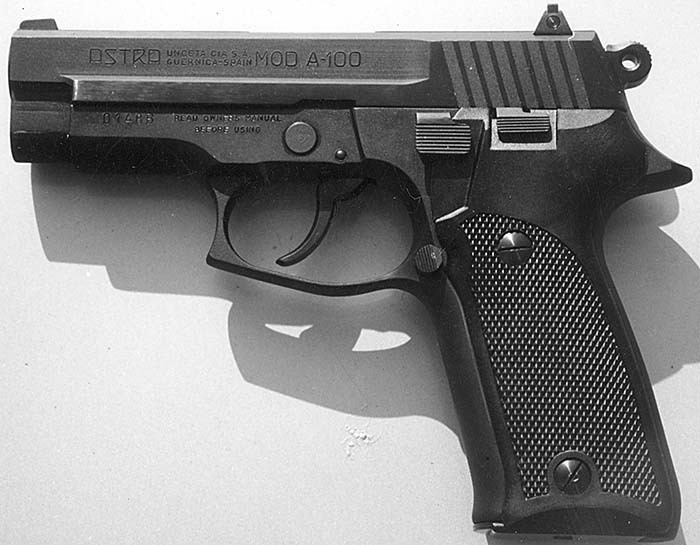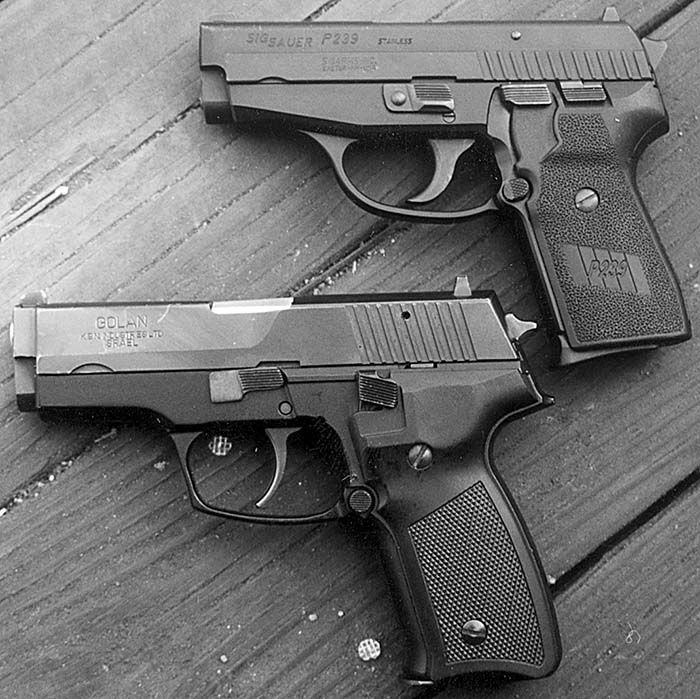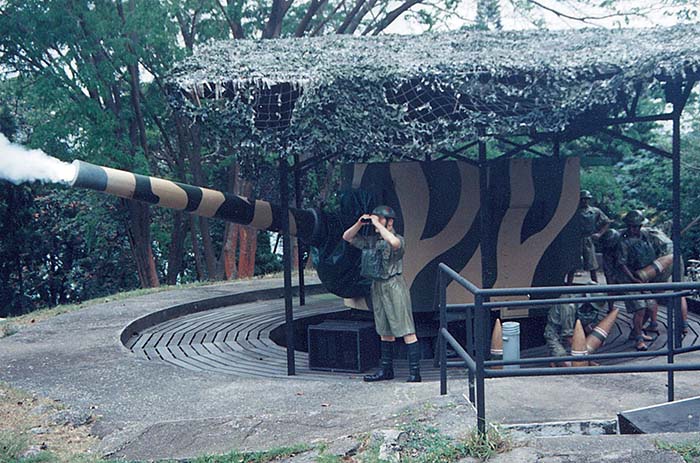The Israeli Golan
By R.K. Campbell
All of the popular modern service handguns have been cloned or copied. Most prominent are the Colt, Browning and Beretta clones. Some are good examples of the gunmaker’s art, others are so rough they appear to have been beat out on a rock in Pakistan- or worse, some of the Pakistani workmanship is amazing. Many are far less expensive than the original, which means something-fit, quality or finish, has been cut somewhere.
Among the most interesting of clone guns are the handful of handguns which emulate the SIG pistol. They are most interesting in that the two popular versions, while obviously designed to mock the SIG’s appearance, differ significantly in mechanical construction.
The Astra A 100 is one of the early clone guns of the SIG. The A 100 has seen some military use in Spain and more civil use. I have fired a number of examples extensively. The A 100 has proven to be an interesting and capable handgun, note worthy on several points. In general construction and handling the A 100 is very SIG-like. The slide has a more pronounced step than the SIG, but does run inside the frame in SIG fashion.
The Astra uses an external extractor, the SIG an internal extractor. The A 100’s takedown lever is located on the opposite side of the frame than the SIG, but operates in a similar fashion. The Astra’s sights are larger than the SIG’s and drift adjustable. In original 9mm hi-capacity versions, the Astra A 100 held 17 rounds in the magazine, a two round advantage over the SIG P 226.

Handfit is not quite up to the SIG, and the trigger reach is longer. The trigger action, while using a SIG-type internal drawbar, is not SIG smooth, breaking at about fourteen pounds in the double action mode and five in the single action mode. Good shooting can be done with practice, but not up to SIG standards.
We must keep the A 100 in perspective. Here is a handgun costing about one third the price of the SIG, yet it is inevitably compared to the more expensive product.
The A 100 has proven to be a reliable handgun. In my experience, it feeds not only ball ammunition but wide mouth hollowpoints with complete reliability. I carried an A 100 9mm pistol extensively for two years. I did not want a pistol that screamed cop on special assignment, but wanted a gun that worked every time I pulled the trigger. The A 100 did that. With good quality (Black Hills) 115 grain hollowpoint ammunition, the A 100 would group five rounds of 9mm Luger ammunition into three inches or slightly more at 25 yards. This is a good standard.
A variation to be avoided is the A 90. This is basically an A 100 with manual safety. The safety is slide mounted and actually operates by moving a two piece firing pin out of battery.
I admit to testing only a single example, but the A 90 I tested tended to rattle to “on safe” during firing strings. I understand they are no longer offered, which does not grieve me.
All in all, the A 100 is a robust pistol more than comparable to anything in the price range.
The Golan pistol is named for a hotly contested piece of real estate. This pistol is another locked breech Browning recoil type pistol, with a double action first shot and single action following. It is offered in both 9mm Luger and .40 caliber Smith and Wesson. In common with the A 100, it will not take SIG magazines or parts, nor does it share any parts with the Astra. It DOES greatly resemble the CZ 99.There are those who feel the Golan is just another CZ 99.

The Golan resembles the SIG but is not SIG-like in many regards. The slide is milled, not stamped, and there is no separate breechblock. The Golan has conventional slide rails. The trigger action is roughly comparable to the Astra, but with slightly shorter trigger reach.
There is a steel insert in the alloy frame where it meets the steel slide which should aid in producing less wear on the frame. While not SIG-type rails the frame rails do run the length of the slide, and slide to frame contact would produce good accuracy. Many of the controls are sheet metal stampings, which is more SIG-like.
The Golan is more like a blocky P 229 than a P 220. It feels reasonably good in the hand and balances well. The sights are excellent for the intended purpose, large and easy to pick up quickly.
The Golan’s claim to fame is that it is fully ambidextrous. There are two decockers and two magazine releases, one for each side. The decocker also performs the slide lock and slide release function, which eliminates the SIG’s slide lock at the rear of the left grip panel.
This is a good thing – and a bad thing. Dual controls make the Golan’s grip thicker – to the tune of about 1.5 inches. This is pretty portly for a defense gun.
And we wonder if we really need dual controls. Left handed SIG users such as Ray Jeter of my local Sheriff’s office assure me that SIG is fully useful to the lefty who simply does it all with his left index finger, and more rapidly than a right handed shooter who uses his thumb.
Also, a dual magazine release is more prone to bumping at some point.
Still, for some users the Golan is ideal. The .40 caliber version proved capable of putting all its Black Hills hollowpoint ammunition into three to four inches at 25 yards, all we can ask. Sight regulation was good. We did experience a magazine failure early on, but the single magazine used for thousands of rounds has performed flawlessly. At about 2,500 rounds the Golan’s front sight began to drift. Feed and cycle reliability has remained faultless despite a spotty cleaning schedule and haphazard lubrication.
The clones are not SIGs, but are fair guns for the offering price. They are good enough if not outstanding. Each is usable but neither really measures up to the SIG.
| This article first appeared in Small Arms Review V3N12 (September 2000) |












